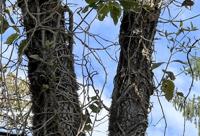English ivy (Hedera helix), a heavy, woody vine with handsome, dark-green, waxy leaves, is believed to have been brought to the New World by European colonists in the 1700s. They likely appreciated its shade tolerance, versatility as both a ground cover and climbing vine, and rapid growth.
But today, it’s classified as an in many parts of the United States, where it grows quickly and can suffocate, starve and .
If you live in one of those regions, you’ve likely seen it climbing tree trunks. And you might be painfully aware of how difficult it is to eradicate.
A MENACE TO TREES
The vine snakes its way up the tree and under its bark, firmly attaching its roots and tendrils as it grows. Simply yanking the ivy would also remove the bark, which serves as the tree’s vital protection from insects, diseases and the elements. In addition, the ivy’s densely packed leaves can block sunlight from reaching the tree, inhibiting photosynthesis, which diminishes the nutrients it can produce.
The weight of the vine weakens branches and, during severe weather, can topple the tree, placing people and property at risk. It’s also a host plant for insect pests that could attack the tree, and mosquitoes that could attack you.
Because its trunk and vines cling sturdily to surfaces via three different methods -- aerial roots, tendrils and a sticky substance called glycosides – removing English ivy should be done carefully to avoid damaging trees.
HOW TO REMOVE IT
Always wear gloves when handling English ivy, as the glycosides will stick to and irritate your skin. Some people also report breathing difficulties when working around the plant; a mask will offer protection. And if you are allergic, it would be best to solicit someone else to tackle the job.
Sever the ivy all around the tree, 3 feet off the ground, using loppers or a hand saw. Then, one by one, carefully separate the detached upper part of each branch from its lower portion, which will still be growing from the ground.
Next, working your way around the tree’s base, dig up all the ivy’s roots and remove the plant from the soil. Keep an eye out for new growth from any roots you might have missed, and pull up new sprouts as you see them.
Allow the severed upper portion of the ivy to remain on the tree. Over the course of about a year, it will die and release its stronghold from under the bark. The withered foliage will eventually blow away.
PROTECT WALLS, TOO
English ivy growing up the side of a brick house risks damage to the structure. As the plant climbs walls, its tendrils become anchored into cracks or gaps in the mortar, which will weaken if the ivy is left in place. Simply pulling the vines down would likely damage that mortar, as well.
Avoid the temptation to apply chemical herbicides, as they may stain the bricks. The leaves’ waxy coating protects it from most weed killers, anyway.
Instead, start by treating the vine as you would if it were growing on a tree: Sever it at the point where its trunks meet the wall and remove the lower portions from the soil.
Next, clip each vine as closely to the wall as possible, but allow the small roots to remain embedded in the mortar for a few weeks. As soon as those roots darken and die, use a stiff brush and detergent to safely scrub them away.
Be sure to assess any damage caused by the plant and make repairs as soon as possible.
—-
Jessica Damiano writes the award-winning and regular gardening columns for The AP. to get weekly gardening tips and advice delivered to your inbox.
—-
For more AP gardening stories, go to








































